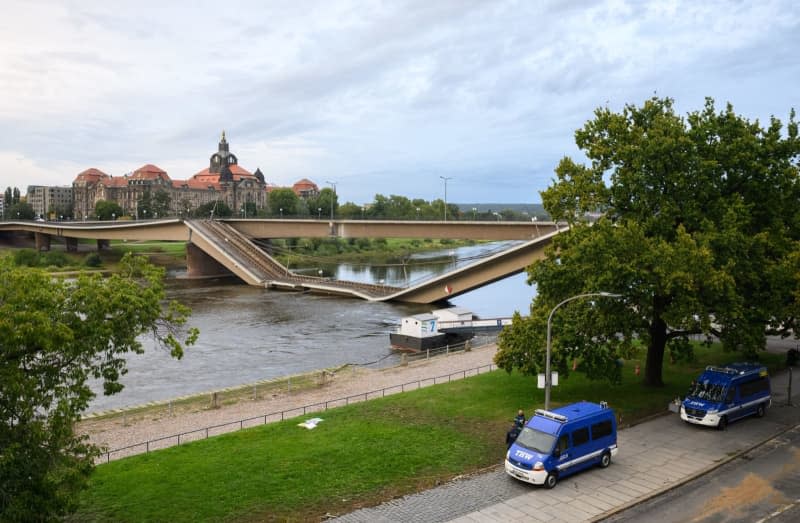Engineers in Germany’s Dresden are demolishing the damaged section of a key bridge on Thursday evening to avert further danger and ahead of forecasted flooding, a day after a section of the bridge collapsed into the river below.
Excavators and demolition vehicles from a specialist company are in operation, fire brigade spokesman Michael Klahre said, as they prepare to partially demolish Bridge Section C, which collapsed into the river below in a night time accident.
“The first priority is the sagging area,” said Klahre, noting laser technology showed remnants of that section of the bridge were slowly subsiding. “We are trying to counteract the collapse,” he said.
Earlier, tram tracks and district heating pipes were separated with small explosions, carried out after a 100-metre safety zone was established.
As the zone includes the state finance ministry and some wings of the State Chancellery, the ministry and affected State Chancellery areas were evacuated first.
Time is pressing for the emergency services as floods are forecast which would significantly increase the danger level.
Some 100 metres of the bridge fell into the Elbe River in an accident that, had it happened at a busier time of day, could have caused disaster, as it is on a key tram, cycling and pedestrian route.
Engineers are bringing down the section of the concrete bridge that is sagging and the cantilever arm that connects to the bank, with the aid of the German Armed Forces, the Federal Agency for Technical Relief (THW) and appropriate technology. It is to be broken up and transported away, an official said earlier.
Officials in Dresden are working as quickly as possible as the river below, the Elbe, is expected to flood on Sunday, due to heavy rainfall forecast in the neighbouring Czech Republic.
Heavy downpours are forecast with the National Flood Centre expecting some 200 millilitres of rain to fall within 72 hours in the Czech Republic and southern Poland by Monday.
In the upper mountain regions, this may increase to 350 millilitres.
The German state of Saxony, where Dresden is located, is also bracing for continuous rainfall in eastern areas and flood warnings have also been issued for rivers nearby such as the Spree and Lausitzer Neiße.
There could be a small flood next week due to the rainfall expected in the Czech Republic, according to the head of the environmental office, René Herold, in the city council.
Water levels are expected to reach between 5 and 8 metres in Dresden by the middle of next week, according to forecasts. Dams on the Czech side of the border are to be lowered slightly as a precautionary measure.
Officials in the Czech Republic said on Wednesday they do not intend to reduce the flow in the Elbe. “I am sure that our Saxon colleagues also understand that a bridge that has actually collapsed cannot now take priority over protecting the property and lives of not only Czech citizens, but also German citizens in particular,” said Czech Agriculture Minister Marek Vyborny.
The day after the partial collapse, safety work was initially carried out on the structure with substructures erected to support the bridgeheads.
Engineers also placed a tachymeter on the bridge, a laser technology to measure changes in the tenth of a millimetre range, the city said, and reference points were installed around the bridge which indicated a slight subsidence.
The bridge’s entire structure is at risk of collapse, the fire brigade said, of the structure that is in total some 400 metres long and made up of three sections connected by crossbeams.
The collapse, just before 3 am (0100 GMT) on Wednesday morning came after two sections of the bridge had recently been repaired.
The city noted how lucky it was that the last tram to pass over the bridge, some 10 minutes earlier, had not been on the structure at the time of the accident and that nobody was injured.
Engineers are investigating what caused the collapse but the police do not believe it was due to external influence.










